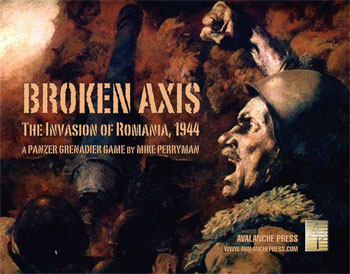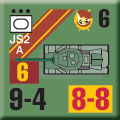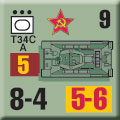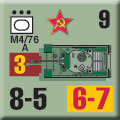Broken Axis:
Soviet Armor
by Mike Bennighof, Ph.D.
January 2022
 Flush with victory, the Soviet Second and Third Ukrainian Fronts charged forward into Romania in the spring of 1944. The Soviet General Staff hoped that they could knock out Germany’s most important remaining European ally, but stout Axis resistance delayed that goal for a further four months. That offensive is the subject of Panzer Grenadier: Broken Axis. Flush with victory, the Soviet Second and Third Ukrainian Fronts charged forward into Romania in the spring of 1944. The Soviet General Staff hoped that they could knock out Germany’s most important remaining European ally, but stout Axis resistance delayed that goal for a further four months. That offensive is the subject of Panzer Grenadier: Broken Axis.
By the spring of 1944 the Red Army of Workers and Peasants had become quite adept at mechanized operations, integrating motorized infantry and cavalry alongside the tanks to carry out the pre-war doctrine of Deep Battle. While the concept proved itself very effective, it would not have been so had the Red Army not possessed capable troops and weapons.
Panzer Grenadier games divide Soviet units into two types, Red Army of Workers and Peasants (RKKA) troops are the standard line troops, and Soviet Guards are the specially-designated units with higher standards of pay and performance, and usually better allotments of weapons.
Here’s a look at the Soviet armor of Broken Axis:
Heavy Tanks and Assault Guns
  
The first echelon’s task under Deep Battle doctrine was to break through enemy positions. The Red Army starting building heavy tanks for this role in the 1930’s, but by 1944 these had long since given way to new and powerful designs.
The JS2 (“Josef Stalin”) heavy tank was derived from the KV-85; its designers had been instructed to produce a vehicle with greater firepower than Soviet medium tanks (something previous heavy tanks had failed to provide) and protection capable of defeating the 88mm and ultra-long-barreled 75mm guns of the German Tiger and Panther tanks.
While not proof against all German anti-tank weapons, the JS2 did provide a good balance of speed, protection and firepower. It served in special heavy tank regiments, assigned to participate in assault operations. Not many were present in the Jassy-Kishinev operations, but they saw a good deal of combat despite their small numbers.
The SU122 assault gun had also been designed for assault operations. It carried a 122mm howitzer in a very low-slung hull built on the chassis of the T34 medium tank, and usually rumbled into battle in the second echelon to blast stubborn enemy positions. Over 1,500 were built, but production ended in the summer of 1944 as even more potent weapons began to be built.
To provide even more firepower against Axis fortifications, the JSU152 assault gun mounted a huge 152mm howitzer on the JS2 hull. In theory it could also be used as a tank destroyer and self-propelled artillery, but the 152mm howitzer did not have the same performance against armor as the purpose-built weapons that armed tanks and tank destroyers. While it could be used for indirect fire, this seldom took place as loading into the vehicle through its armored hatches took a great deal of time and gave the gun a very low rate of fire. Since the JSU152 rarely operated in the role of actual artillery, the JSU152 piece in the game is limited to direct fire.
Medium Tanks
   
Three years after the Axis sneak attack on the Soviet Union, the T-34/76 – the Hammer of the Proletariat – remained a potent weapon. But German answers to its combination of speed, armor and firepower had finally reached the battlefield: the Panther and Tiger tanks, and the upgraded PzKpfw IV with a longer-barreled 75mm gun. All of these could destroy the T34 from outside the effective range of its own armament, the 76.2mm F34 gun.
As a stopgap measure to get a more powerful anti-tank gun into the hands of the armored forces, production of the SU122 assault gun gave way to a very similar vehicle, the SU85, armed with the high-velocity D-5T 85mm gun. The vehicle was more capable of destroying the big new German tanks than the T34/76 or the SU122, but still fell short and would be in turn replaced by the SU100 with a 100mm gun.
In August 1943, the Defense Committee of the People’s Commissariat directed that future models of the T-34 would carry an 85mm tank gun. The D-5T gun of the SU85 was much too heavy to mount in a turret on the T-34, requiring design of a lighter piece. The Krasnoye Sormovotank factory designed a new, enlarged turret but the new 85mm gun suffered a series of developmental delays. The new weapon was finally approved in January 1944, six weeks after the tank had been formally accepted by the Red Army. Over 29,000 models were produced by the end of the war.
As redesigned, the T-34/85 gained less than two tons over the 1943 model T-34/76 and lost only a slight edge in speed though it exerted somewhat more ground pressure. The hull was identical to the older model, but the larger turret and its overhang made the tank an easier target for German gunners. But tank crews considered these disadvantages more than offset by the bigger gun: the ZIS-S-53 fired a round half again as heavy as the 76.2mm F34 tank gun, and with far greater effect. Where the older weapon could penetrate 69mm of armor at 500 meters, the new one was credited with punching through up to 110mm. It had greater range and yet maintained the same rate of fire.
The T-34/85 equipped the vast majority of Soviet tank units in the last year of the war and proved an extremely deadly weapon. It would soldier on for many years after the war as well, seeing action in Korea, the Middle East and elsewhere.
Borrowed Tanks
 
The 4,100 M4 Sherman tanks shipped to the Red Army were split almost evenly between those armed with 75mm guns and those with the much more effective 76mm weapon. By the summer of 1944 the Red Army had begun to re-equip entire corps with the Shermans for ease of maintenance and supply. Sherman tanks supplied to the Soviets were powered by a diesel engine, reducing their alarming tendency to explode when hit by enemy fire.
Almost as many Valentine tanks were shipped to the Soviet Union as Shermans, with production coming from both British and Canadian factories. Except for 30 vehicles kept in Canada for training purposes, all Canadian-built models went to the Red Army. The Valentine first appeared at the front in December 1941 and remained in service until the end of the war. By the spring of 1944 the Valentine usually only appeared in second-line units, but some brigades still equipped with the tanks fought in the Jassy-Kishinev campaigns.
And those are the Soviet tanks found in Broken Axis. The pieces themselves are beautiful: silky-smooth and die-cut with minimal force, leaving them flush on both sides.
You can order Broken Axis right here.
Please allow an additional five weeks for delivery.
Sign up for our newsletter right here. Your info will never be sold or transferred; we'll just use it to update you on new games and new offers.
Mike Bennighof is president of Avalanche Press and holds a doctorate in history from Emory University. A Fulbright Scholar and NASA Journalist in Space finalist, he has published an unknowable number of books, games and articles on historical subjects.
He lives in Birmingham, Alabama with his wife, three children and his dog, Leopold.
Want to keep Daily Content free of third-party ads? You can send us some love (and cash) through this link right here.
|
